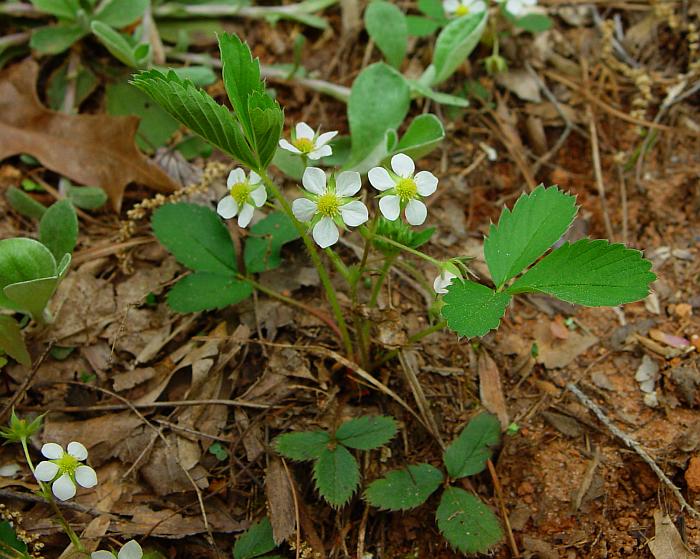Fragaria virginiana Mill.
Wild Strawberry

Native
CC = 3
CW = 3
MOC = 82
© DETenaglia
Fragaria virginiana Mill.Wild Strawberry | |
 |
Native CC = 3 CW = 3 MOC = 82 |
© DETenaglia |
|
Family - Rosaceae Habit - Perennial forb with short, stout rhizomes. Stems - Aerial stems absent. Slender, prostrate to arched stolons present, these rooting at the tip, hairy, usually with 1 scalelike leaf toward the midpoint, this 3-10 mm long, simple, linear to narrowly lanceolate, entire, often wrapped around the stolon at the base. Leaves - Rosettes at rhizome tips and rooting nodes of stolons, trifoliate, stipulate, long-petiolate, the petioles hairy. Stipules acute, 2 cm long, 5-6 mm broad, glabrous except for villous midvein. Leaflets 1.5-11.0 cm long, sessile or more commonly short-stalked, firm-textured, the margins scalloped or toothed, the terminal tooth mostly less than 1/2 as wide as and with the tip not extended beyond those of the immediately adjacent lateral ones, the upper surface sparsely to moderately hairy, green to dark green or bluish green, the undersurface nearly glabrous to densely silky-hairy, sometimes yellowish-or grayish-tinged.
Inflorescence - Usually shorter than the leaves at both flowering and fruiting, sometimes appearing umbellate, the main stalk to 15 cm long, with appressed-ascending or more commonly spreading, fine long hairs. Flowers - Sepals 5-10 mm long, ascending, spreading, or reflexed at fruiting, sericeous. Petals 5, white, 7-10 mm long, 5.5 mm broad, glabrous, orbicular to broadly obovate, spreading. Stamens numerous, borne at edge of receptacle. Filaments 1.5 mm long, yellow, glabrous. Anthers yellow. Pistils many. Hypanthium broadly conic, 2 mm long. Bractlets 5, linear, to 5 mm long, 1.2 mm broad, sericeous, alternating with sepals.
Fruits - Achenes, positioned in shallow pits in the surface of the enlarged (to 1.5 cm) receptacle. A strawberry.
Flowering - April - May. Habitat - Openings of mesic to dry upland forests, savannas, prairies, ledges and tops of bluffs, and calcareous glades, fields, railroads, roadsides, and open disturbed areas. Origin - Native to the U.S. Lookalikes - F. vesca. Other info. - This is the wild strawberry plant, found throughout Missouri and in some form across the entire continental U.S. Plants in Missouri have been called ssp. virginiana, with two other subspecies (ssp. glauca and ssp. platypetala) being found in other geographical regions to our west. Yhe plants are unmistakable to anyone who has grown strawberries in a garden, as they closely resemble the cultivated form. The lookalike species F. vesca is much rarer in Missouri, and differs by having smaller flowers, the terminal tooth of the leaflet extending past the adjacent teeth, and fruits lying on the surface of the expanded receptacle rather than in pits. Photographs taken at the Kansas City Zoo, 4-7-00 and in Brown Summit, NC., 4-24-03 (DETenaglia); also at St. Joe State Park, St. Francois County, MO, 5-31-2010, Cuivre River State Park, Lincoln County, MO, 4-2-2012, Tucker Prairie Natural Area, Callaway County, MO, 4-28-2016, and St. Joe State Park, St. Francois County, MO, 4-26-2020 (SRTurner). |